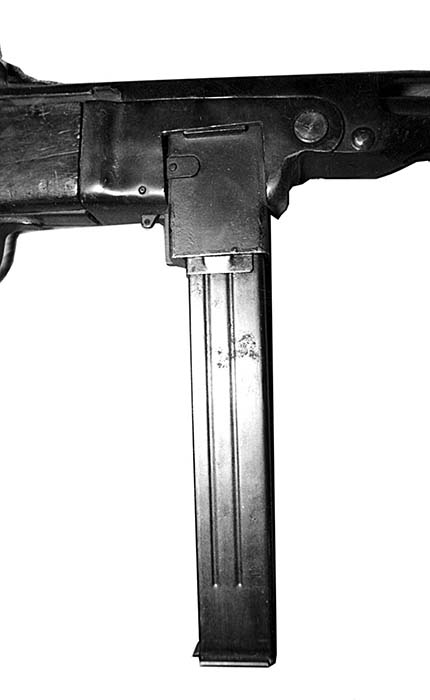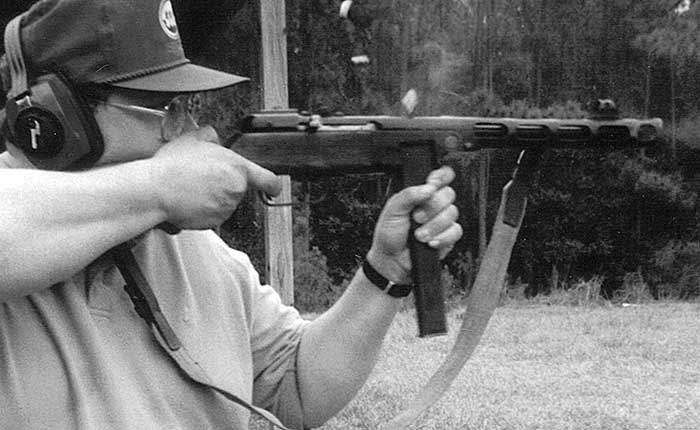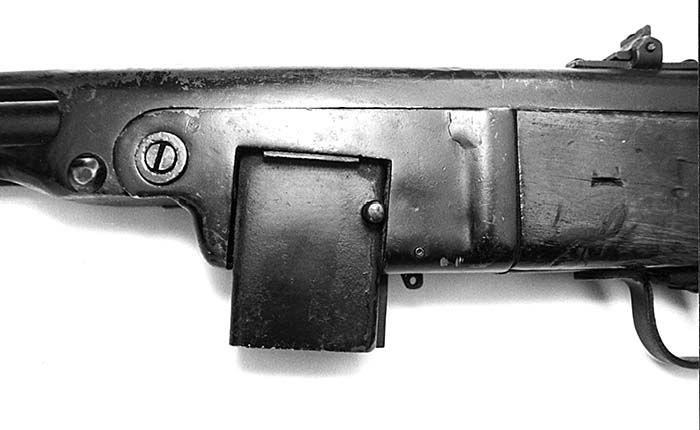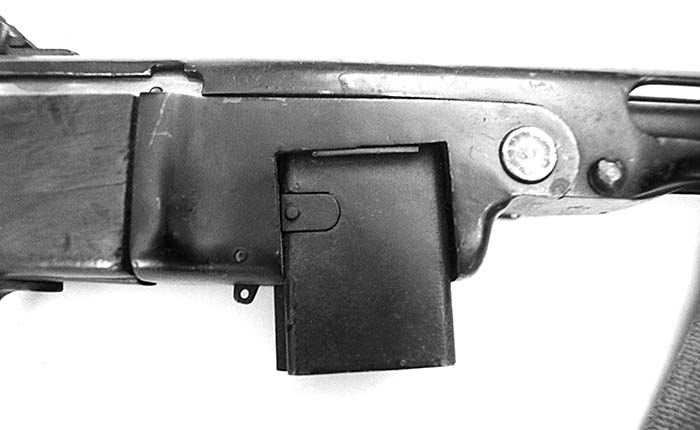By Frank Iannamico
The German Wehrmacht fielded a greater assortment of small arms and ammunition during WWII, than any other nation involved in the war. This situation was created by several factors; the lack of indigenous factories to produce weapons, the constant Allied bombing of existing German weapon factories, and the many foreign weapons and weapons producing factories captured and pressed into service by the Germans during their highly successful European campaign early in the war.

The Nazi’s rapid conquest of many European countries resulted in the capture of many pistols and rifles, as well as tanks and artillery pieces. In addition to weapons, the Germans inducted many “recruits” from the conquered nations into the Wehrmacht.
The German Army was always short of arms, and put to use basically every weapon they captured. Unfortunately for the Nazis there were few European armies equipped with submachine guns. Most of the submachine guns used by the Wehrmacht in the early years of the war, were their own MP38/40s, and earlier German models; the MP28, MP34 and MP35. The Italians, who were allied with the Germans, provided some of their excellent Beretta 38A and the 38/42 9mm subguns. This was advantageous for the Germans whose own MP38 and MP40 submachine guns used the same 9mm Parabellum cartridge as the Italian weapons.
Russia proved to be a major source of weapons for the Nazis, after the German invasion (Operation Barbarossa) of that country began on June 22, 1941. One of the Nazi’s favorite submachine guns were those captured from the Russians on the Eastern Front, primarily the PPSh41 in the 7.62×25 caliber. A Soviet PPSh 41 submachine gun was a highly coveted, and useful prize for the German soldier.
The PPSh had a very fast cyclic rate, and a drum magazine that featured a huge 71 round capacity. 35 round stick magazines were also issued for use in the PPSh41. A PPSh firing a 71 round burst of the loud 7.62 Tokarev cartridge is quite intimidating, perhaps more so than actually effective. In addition to the quick cyclic rate and the enormous magazine capacity, the crude appearing PPSh was a rugged reliable design, impervious to dirt and cold weather. Captured 7.62 PPShs were designated the MP.717(r) by the German Wehrmacht.
The Russian PPSh41 was developed to replace the PPD1938 and the PPD1940 submachine guns. The advantages of the PPSh were they could be manufactured inexpensively, and more importantly, it could be produced faster than the PPD submachine guns that preceded it.
The PPSh was designed in the Soviet Union by Georgiy Shpagin in 1940. The PPSh41 is often referred to, unofficially, as the Shpagin submachine gun in honor of its designer. The PPSh was the Soviets first attempt at producing an inexpensive weapon from sheet metal stampings. The PPS43, an even simpler subgun, was developed and produced later in the war. Soviet manufacture of the PPSh41 began in the fall of 1941. Over 5 million PPSh41s were produced during WWII making it the most prolific subgun of the war. After the end of WWII, the PPSh design was copied, and produced by several other communist satellite nations. Iran, one of the countries to produce the post war PPSh as the Model 22, reportably made a version of the gun chambered in 9mm Parabellum.

The PPSh as issued to the Soviet Army, has a 33.1” overall length. The barrel is chrome lined and 10.6” in length. Weight is 8.03 lbs unloaded. Magazine capacity is, as mentioned earlier, a 71 round drum or a 35 round stick magazine. Although the large capacity drum contains a lot of firepower, it also adds 4 pounds of weight to the weapon when fully loaded. Wide spread use of the drum type magazine soon gave way to the easier to produce 35 round box style magazine, as the war progressed.

A few Early PPSh models featured a tangent sight calibrated out to 500 meters. Later production weapons have a simpler U notch flip sight with 100 and 200 meter calibrations. The PPSh is capable of both semiautomatic and full auto operation. Cyclic rate with the original 7.62×25 cartridge is a quick 900+ rounds per minute. Muzzle velocity of the 7.62 cartridge is 1600 feet per second. Though crudely built, the weapon is extremely simple, rugged and reliable. The PPSH is an open bolt/blow back design.
The German Wehrmacht soldiers obviously felt that their own MP40 submachine guns were at a disadvantage with the issue 32 round magazine, when compared to the 71 round Soviet PPSh41. The German weapons engineers went to work on the problem, and came up with the MP40/II variation that held two standard 32 round MP40 magazines in a bracket attached to the receiver. When one magazine was emptied it simply was unlatched, and slid to the side. The other loaded magazine would then manually be moved and locked into position. It was most likely not considered very successful, as very few were produced. The MP40/II’s are quite rare and are highly sought after by MP40 collectors today.
Some of the Soviet PPSh41s that were captured on the Eastern Front were returned to Germany and converted to 9mm Parabellum, the standard pistol and subgun cartridge of the Nazis. The conversion consisted of replacing the Russian 7.62 barrel with a 9mm barrel of approximately the same length, and installing an adapter in the PPSh magazine well to accept the German MP40 32 round magazine.
Strangely enough the conversion to 9mm and the 32 round magazine, took away from the PPSh the very feature the Germans troops obviously liked the most, the 71 round drum magazine. The conversion was undoubtedly performed to make the logistics of supplying replacement magazines and standard issue German 9mm ammunition easier. The captured Russian PPSh submachine guns converted to 9mm were designated the MP41.(r) by the Wehrmacht.
The conversion to 9mm reduces the PPSh’s cyclic rate to approximately 800 rounds per minute. Although the trajectory of the Nazi 124 grain 9mm projectile at 1250 feet per second is different than the Russian 86 grain slug at 1600 fps, the PPSh sights remained unaltered in the conversion.
The original PPSh magazine latch holds the German 9mm magazine adapter securely in the weapon. The PPSh latch release lever is removed to prevent accidental release of the adapter, although the adapter was a very tight fit in the gun examined. The German 9mm magazine adapter has its own magazine release button located on the left side of the magazine housing.
The weapon can easily be converted back to its original 7.62 configuration by simply removing the 9mm magazine adapter, and reinstalling the original magazine release lever. The PPSh barrel is simply pressed and pinned into position and can be easily removed and replaced with simple hand tools.
I recently stumbled upon a genuine WWII Nazi converted 9mm PPSh while attending a recent Knob Creek Shoot in Kentucky. It immediately caught my attention. The gun was lying on a table in the gun show area, although it was not for sale. The owner of the PPSh, Bill Zukauskas, was very helpful in providing information about the gun. He even disassembled the weapon for me so I could photograph the Waffenamts stamped on the barrel.
Bill explained to me that he had acquired the PPSh from a gentleman who had originally liberated it from a German SS soldier, when his U.S. Army unit was entering Germany in 1945. Fortunately, the gentleman had the opportunity to register the gun in 1968. I’m not sure how many of these Nazi converted PPShs there are still in existence, but this was the first one I had ever seen outside of a museum. Bill said that he does occasionally fire his 9mm PPSh, but not very often. Its easy to understand why, the gun would unquestionably fit into the advanced collector category.

It’s intriguing to think of all the action and history this particular PPSh41 surely endured in WWII. (Scenario based on conjecture) First carried by a Russian soldier desperately defending his homeland, until it was captured by a German soldier fighting on the Eastern Front. The gun was eventually sent to a German arsenal to be converted to 9mm, and reissued to defend against the Allied invasion of Germany, only to be liberated by a U.S. soldier near the end of the war. The weapon returned to the U.S. with the soldier and was kept in his possession for almost 50 years! The PPSh would finally end its long journey, and retire into the fortunate hands of Bill Zukauskas, a very appreciative collector.
| This article first appeared in Small Arms Review V1N6 (March 1998) |











